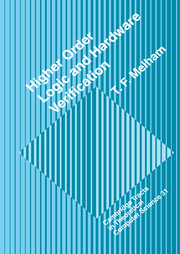5 - Data Abstraction
Published online by Cambridge University Press: 21 January 2010
Summary
Data abstraction is based formally on the use of logical types to model data. To make effective use of data abstraction, it is generally necessary to define special-purpose types for both design models and specifications of required behaviour. The formal properties these types are required to have will depend on the kind of behaviour being specified, on the level of abstraction at which the devices are described, and on how accurate the specifications are intended to be.
This means that no fixed collection of logical types can be an adequate basis for specifying all devices. The types bool and num→bool, for example, are sufficient for specifying hardware behaviour at the level of abstraction where the devices used are flip-flops and combinational logic gates. But at the level of abstraction where the primitive components are transistors, an accurate model of behaviour has to account for more kinds of values than can be represented by the two truth-values T and F. It may be necessary to represent electrical signals of several different strengths, or to represent ‘undefined’ or ‘floating’ values. The types bool and num→bool are also insufficient for specifications at the register-transfer level of abstraction, where it is often necessary to specify behaviour not in terms of the values on single wires but in terms of vectors of bits and arithmetical operations on fixed-width binary words. At the architecture level, concise specifications may require comparatively complex abstract data types, such as stacks and queues.
- Type
- Chapter
- Information
- Higher Order Logic and Hardware Verification , pp. 69 - 96Publisher: Cambridge University PressPrint publication year: 1993



